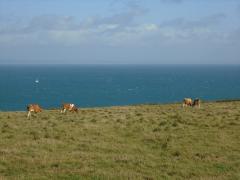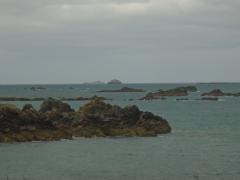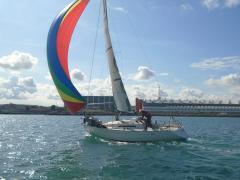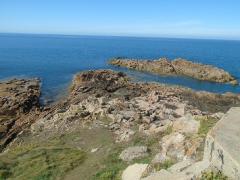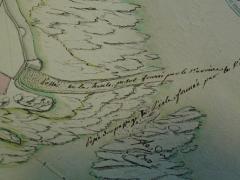What with the weather getting a bit autumnal (though the sail over was in ideal conditions), four nights moored at Alderney in winds up to 35 knots was not my idea of comfort on a boat, but it meant I could meet up with friends Georges and Catherine, who were on their way back from Guernsey, visit the museum and walk round some of the island with them, as well as attend the two-day Henry Euler Memorial Trust maritime history symposium on 'Alderney, The Channel Islands & Anglo-French Relations 1689 – 1918', with a number of eminent French and British speakers.
The calm of each day's proceedings at the symposium was a contrast to some windy nights in the port, though it was hard to choose between listening to French scholars constrained by the cultural limitations of the project to give their papers in English, and the wind in the rigging in the night; for a mixture of reasons I was finally glad to be able to sail away from Braye last Saturday and cross the Raz Blanchard to head up the coast to Cherbourg.
Drifting along past Basse Bréfort and Omonville in a light N breeze, carried mainly by the tide, I arrived in the rade just in time to photograph friends who were sailing in the CNC singlehanded series race, and to join them in the bar afterwards. The week has passed quickly – on Tuesday I was invited to helm the J22 I sailed last year, and we were able to preserve the boat's honour by winning our class, while yesterday afternoon I was on the Dufour 34 with Philippe and Armelle and friends for a sail up to Cap Lévi then a long spinnaker run down towards Omonville in the sunshine; in between I was working mid-week at Saint-Vaast with Catherine, who is my translator, on revising an article to send to a journal over here, thanks to a contact I made at the conference.
Saturday's sail and a big low tide also convinced me that it was worth heading back along the coast on my bike on Sunday to try to identify the landing-stages cut in the rock by 18th century subcontractors to enable boats to load stone more easily for the breakwater, which I was able to verify on charts in the archives today.
Choosing photos to illustrate this article, I was struck by a passing similarity between Bruegel's 'Fall of Icarus' and my picture of cows calmly ignoring the yacht braving 30 knots of wind to take the tide down to Guernsey – not an enviable passage!
Steve Fraser
'Aliya'

